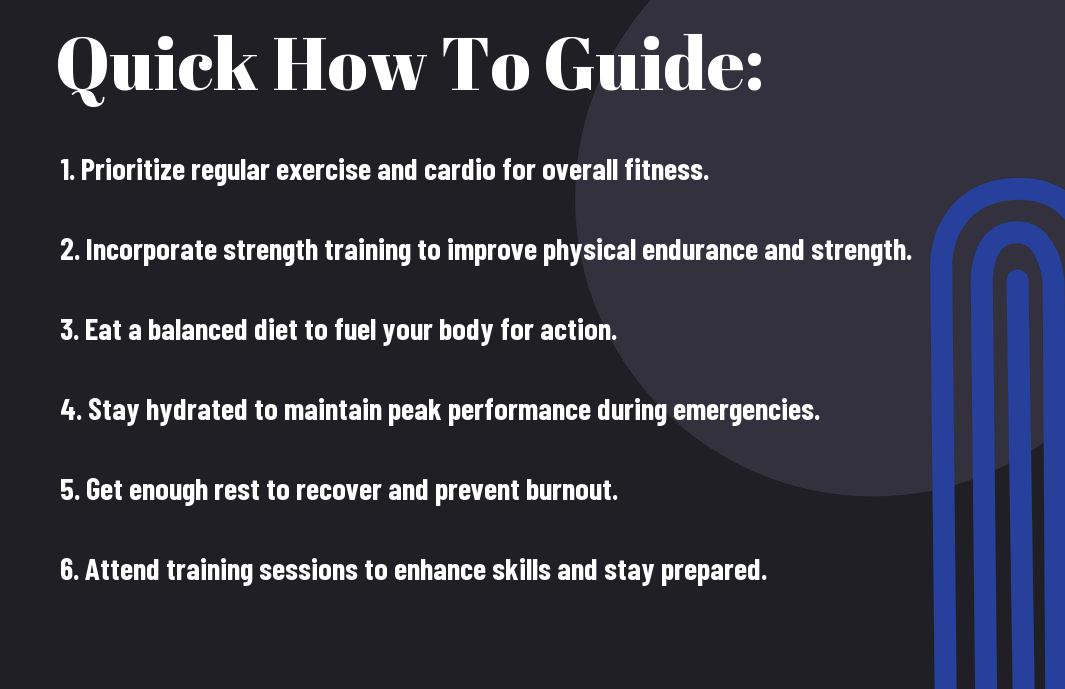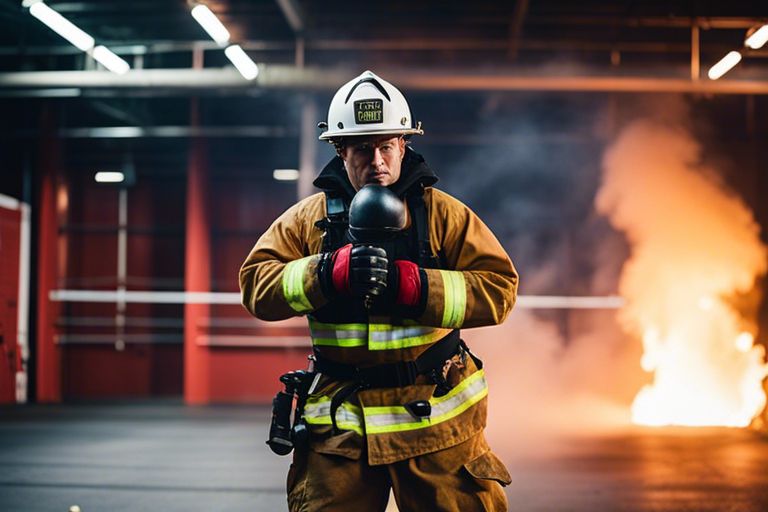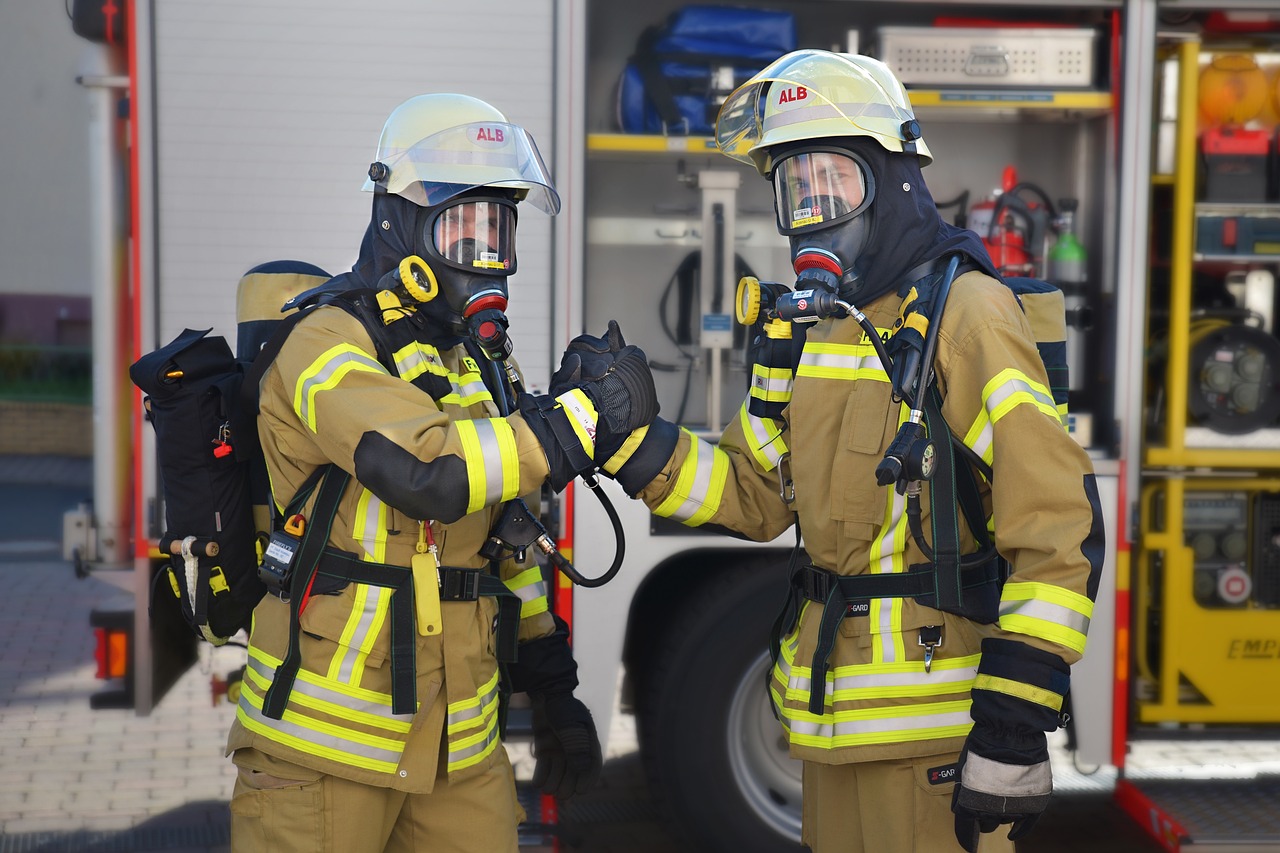Most volunteer firefighters not only risk their lives but also need to maintain peak physical fitness to perform their demanding duties effectively. In this guide, you will discover important tips and exercises to help you stay fit and ready for any emergency that comes your way as a volunteer firefighter. From cardio workouts to strength training, your health and well-being are crucial for your role in saving lives in your community.
Understanding the Physical Demands of Volunteer Firefighting
Your role as a volunteer firefighter requires more than just bravery and quick thinking. Physical fitness is a key component to successfully performing the duties of a firefighter. Understanding the physical demands of the job can help you tailor your fitness routine to ensure you are prepared for the challenges you may face on the job.
Factors Affecting Physical Fitness on the Job
- Cardiovascular endurance: Firefighting requires bursts of intense activity, so having good cardiovascular endurance is crucial to prevent fatigue.
- Strength: You need upper body, lower body, and core strength to carry gear, climb stairs, and rescue individuals.
- Flexibility: Being able to move freely and comfortably in tight spaces is vital during firefighting operations.
This understanding can help you focus on building a well-rounded fitness routine that addresses the specific physical demands of firefighting. It’s important to incorporate cardiovascular training, strength training, and flexibility exercises into your workouts to ensure you are prepared for any situation.
Common Injuries and Health Risks Faced by Volunteer Firefighters
There’s a range of common injuries and health risks that volunteer firefighters face due to the physically demanding nature of their job. These include musculoskeletal injuries, heat stress, smoke inhalation, and exposure to hazardous materials. It’s crucial to be aware of these risks and take precautions to mitigate them.
Injuries such as strains, sprains, and fractures are common among firefighters due to the heavy gear they wear and the physical exertion required during emergency responses. Heat stress and smoke inhalation can lead to serious health issues, so proper hydration and wearing protective gear are vital to minimize these risks. Additionally, exposure to hazardous materials can have long-term health effects, emphasizing the importance of proper training and safety protocols.
Creating a Fitness Plan
Now that you have decided to focus on your fitness as a volunteer firefighter, it’s important to create a well-rounded fitness plan tailored to your needs and goals. This involves setting realistic goals and objectives, incorporating cardiovascular exercise into your routine, and building strength and endurance through resistance training.
Setting Realistic Goals and Objectives
An crucial first step in creating your fitness plan is setting realistic goals and objectives that you can work towards. This could include improving your endurance during emergency situations, increasing your overall strength, or losing a certain amount of weight. By setting achievable goals, you can stay motivated and track your progress effectively.
Incorporating Cardiovascular Exercise into Your Routine
One of the key components of a firefighter’s fitness regimen is cardiovascular exercise. This type of exercise helps improve your heart health, endurance, and stamina, which are crucial for firefighting operations. You can incorporate cardiovascular exercise into your routine by running, cycling, swimming, or engaging in high-intensity interval training (HIIT) workouts.
Exercise that gets your heart rate up and makes you break a sweat is crucial for improving your cardiovascular fitness. Aim to include at least 150 minutes of moderate-intensity cardio each week, or 75 minutes of vigorous-intensity cardio, to keep your heart and lungs strong.
Building Strength and Endurance through Resistance Training
Building strength and endurance through resistance training is another vital aspect of your fitness plan as a volunteer firefighter. This type of training helps you develop the physical strength needed to carry out firefighting tasks effectively. Include exercises such as weight lifting, bodyweight exercises, and resistance band workouts in your routine to build muscle and endurance.
Resistance training not only strengthens your muscles but also improves your bone density and metabolism. By incorporating resistance training into your fitness plan, you can enhance your overall physical performance and reduce the risk of injury during emergency response situations.
Nutrition and Hydration for Optimal Performance
Many Physical Fitness for Volunteer Firefighters resources emphasize the importance of proper nutrition and hydration for optimal performance. As a volunteer firefighter, it’s crucial to fuel your body adequately and stay hydrated to meet the physical demands of firefighting duties.
Fueling Your Body for Physical Activity
Some of the key components of fueling your body for physical activity include consuming a balanced diet rich in proteins, carbohydrates, and healthy fats. Proteins help with muscle repair and recovery, carbohydrates provide energy for physical exertion, and healthy fats aid in overall body function. Make sure to incorporate a variety of fruits, vegetables, whole grains, and lean proteins into your meals to support your active lifestyle.
Staying Hydrated on the Go
While on the go during firefighting emergencies, staying hydrated is imperative for maintaining peak performance. Dehydration can lead to decreased cognitive function, reduced physical endurance, and impaired decision-making abilities. Make sure to carry a water bottle with you at all times and take regular hydration breaks during extended missions to prevent dehydration.
Understanding
Meal Planning and Snacking Strategies
Planning your meals and snacks ahead of time is crucial for ensuring you have access to nutrient-dense foods when on duty. Opt for portable snacks like nuts, fruits, yogurt, or granola bars to keep your energy levels up during long shifts. Additionally, preparing meals in advance can help you make healthier choices and avoid relying on fast food or vending machine options.
Physical fitness for volunteer firefighters goes beyond just exercise—it also includes proper nutrition and hydration strategies to support your overall performance and well-being. By prioritizing a balanced diet, staying hydrated, and planning your meals effectively, you can optimize your physical readiness for any firefighting challenges that come your way.
Tips for Staying Active on a Busy Schedule
Despite your hectic schedule as a volunteer firefighter, staying fit and active is imperative for maintaining your physical capabilities during emergencies. Here are some tips to help you stay active even with your busy schedule:
Finding Time to Exercise Despite Volunteer Firefighting Commitments
Volunteer firefighters often struggle to find time for exercise due to their unpredictable schedules. However, it is crucial to prioritize your physical fitness to perform efficiently during emergencies. To manage your time effectively, consider creating a workout schedule that aligns with your firefighting shifts. Additionally, incorporating high-intensity interval training (HIIT) or quick bodyweight exercises can be efficient ways to stay active even on your busiest days. For more tips on how physically fit you should be as a volunteer firefighter, check out How physically fit should I be to be a volunteer firefighter.
Incorporating Physical Activity into Daily Life
Volunteer firefighters can enhance their physical fitness by incorporating small bouts of activity into their daily routines. Simple actions like taking the stairs instead of the elevator, doing bodyweight exercises during TV commercials, or going for a brisk walk during your break at the fire station can make a significant difference. By making these small but consistent efforts, you can improve your overall fitness levels and prepare your body for the demands of firefighting.
This approach not only helps you stay fit but also ensures that you are always ready to respond effectively during emergencies.
Making the Most of Limited Time and Resources
Now, you may feel overwhelmed by your commitments as a volunteer firefighter and struggle to allocate time for exercise. However, it’s imperative to recognize that even short, intense workouts can be beneficial for your physical conditioning. Consider investing in a few pieces of basic workout equipment like resistance bands or dumbbells that can be easily stored at the fire station. This allows you to squeeze in quick workouts between calls or during downtime, maximizing the use of your limited time and resources.
Daily physical activity can have a profound impact on your overall health and performance as a volunteer firefighter. By incorporating exercise into your daily routine and making the most of the time and resources available to you, you can maintain your fitness levels and be better prepared to serve your community in times of need.
Factors to Consider for Volunteer Firefighters with Specific Needs
Once again, it’s important to understand that as a volunteer firefighter, you may have specific needs or considerations that can impact your fitness routine. Here are some factors to consider:
- Fitness Strategies for Older Volunteer Firefighters
- Accommodating Physical Limitations and Injuries
- Staying Fit as a Female Volunteer Firefighter
Fitness Strategies for Older Volunteer Firefighters
Even as you age, it’s crucial to maintain a level of fitness that supports your role as a volunteer firefighter. Focus on exercises that improve flexibility, strength, and cardiovascular health. Consider low-impact activities like swimming, walking, or yoga to reduce the risk of injury. Any fitness routine should take into account your current fitness level and any age-related concerns you may have.
Accommodating Physical Limitations and Injuries
Limitations can arise due to pre-existing conditions or injuries sustained during firefighting duties. With proper guidance from a healthcare professional or fitness trainer, you can modify exercises to accommodate these limitations. It’s important to listen to your body and avoid pushing yourself too hard, which could worsen your condition. Note, safety should always be your top priority when adapting your fitness routine.
Staying Fit as a Female Volunteer Firefighter
With the unique challenges that female firefighters may face, such as lower upper body strength on average compared to males, it’s important to focus on strength training exercises that target the core and upper body. Incorporating activities like weightlifting and bodyweight exercises can help improve strength and overall performance. Additionally, pay attention to proper nutrition and hydration to support your fitness goals and recovery. Note, your dedication to maintaining a high level of fitness is crucial for your role as a volunteer firefighter.
Staying Motivated and Accountable
Keep yourself motivated and accountable to maintain your fitness as a volunteer firefighter. Finding ways to stay on track with your workout routine is important for your overall health and readiness for emergency situations.
Finding a Workout Buddy or Accountability Partner
Clearly, having a workout buddy or accountability partner can significantly boost your motivation. **Sharing your fitness goals and progress with someone else can provide you with the support and encouragement you need to stay committed**. Look for a fellow firefighter or friend who shares your dedication to staying fit, and schedule regular workout sessions together. Knowing that someone is counting on you to show up can help you stay consistent with your exercise routine.
Tracking Progress and Celebrating Successes
One way to stay motivated is to **track your progress** and celebrate your successes along the way. **Keep a workout journal** to record your exercises, reps, and sets. Setting specific, measurable goals allows you to see how far you’ve come and gives you something to strive for. **Celebrating your achievements, no matter how small, can help you stay motivated and focused on your fitness journey**.
**This continual tracking and acknowledgment of your progress can help you stay accountable** to your fitness goals. Identify milestones, such as lifting heavier weights or running longer distances, and reward yourself when you reach them. **Having a visual representation of your improvements can boost your confidence and drive to keep pushing yourself**.
Overcoming Plateaus and Staying Engaged
Even with the best intentions, you may encounter plateaus in your fitness journey. **To overcome these challenges, mix up your routine by trying new exercises or activities**. Incorporating **strength training, HIIT workouts, or yoga** can help prevent boredom and keep your body challenged. **Engaging in group fitness classes or online challenges can also provide a fresh perspective and help you stay motivated**.

To wrap up
To wrap up, as a volunteer firefighter, it is crucial to prioritize your physical fitness to ensure you can perform your duties effectively and safely. By incorporating a balanced exercise routine, healthy eating habits, and regular physical assessments into your lifestyle, you can maintain your strength, endurance, and overall health. Remember that staying fit not only benefits you but also allows you to better serve your community in times of need.



